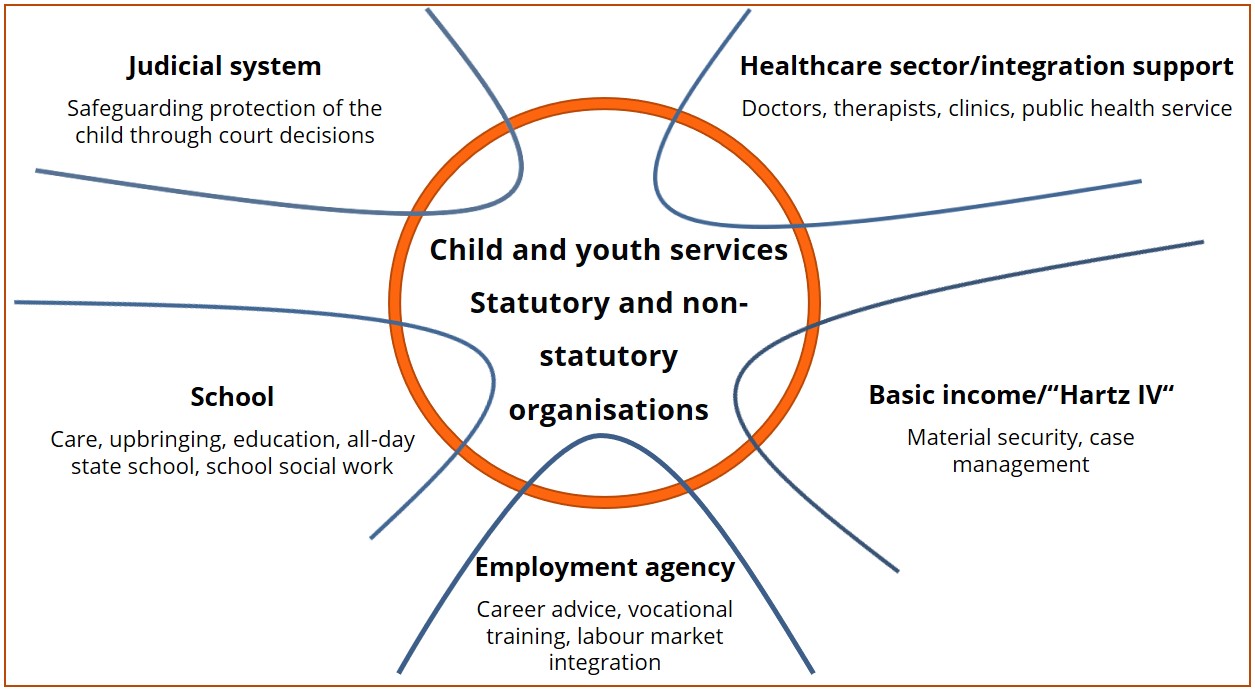Notes
Far from being a standalone field, child and youth services forms part of a social action system that intersects with many other service organisations and action systems. These firstly comprise the institutions listed in Book 8 of the Social Code (SGB VIII), whose target groups include young people and families (see Article 81 SGB VIII). Beyond this, child and youth services is also required to participate in all political and societal debates on shaping the conditions in which young people grow up.
The Children and Youth Welfare Act (SGB VIII) expressly requires structural cooperation with certain bodies and organisations from other action systems. This is described in Article 81 as follows:
Organisations active in the field of statutory youth services must work with other bodies and public-sector institutions whose activities affect the lives of young people and their families, in particular with
- the providers of social services pursuant to Books 2, 3, 4, 5, 6 and 12 of the Social Code, as well as the providers of services in accordance with the Federal Pensions Act (Bundesversorgungsgesetz/BVG),
- the providers of rehabilitation services pursuant to Article 6 (1) no. 7 of Book 9 of the Social Code,
- the family and youth courts, the public prosecutors and the law enforcement authorities,
- schools and school administrative bodies,
- public healthcare establishments and bodies and other healthcare facilities and services,
- pregnancy counselling centres pursuant to Articles 3, 8 of the German Act on Assistance to Avoid and Cope with Conflicts in Pregnancy (Schwangerschaftskonfliktgesetz/SchKG) and addiction counselling centres,
- establishments and services for protection against violence in close relationships,
- the centres of the Federal Employment Agency,
- establishments and bodies for initial and continuing vocational education and training,
- the police and public order authorities,
- the labour inspectorate, and
- institutions for expert training, continuing vocational training and research
within the scope of their duties and powers.
Given that a central mandate of child and youth services is help maintain or create positive living conditions for young people and their families and a child- and family-friendly environment (see Article 1 [3] Social Code Book VIII), structuring the diverse interfaces to other action systems within German society forms an ongoing task. Often referred to as a duty to intervene, this task requires constant interaction with the relevant systems and it falls to child and youth services to ensure that such systems also consider the concerns of children and adolescents and contribute to providing a nurturing environment for growing up.
Dealing with the many different reference systems of other action systems and cooperating with the professions involved is incredibly challenging for all sides. Not least since the logics underlying institutional and professional activities differ in terms of the legal foundations, financing sources and modalities, institutional and societal mandates, and the knowledge specific to the professions and their conventions of action.
Despite these barriers to cooperation, interdisciplinary and inter-institutional cooperation with the action systems described is a prerequisite for and expression of an affirmative, lifeworld-oriented child and youth services that considers all social conditions of growing up in its analysis and actions.
Further reading
- Seckinger, Mike/van Santen, Eric (2003): Kooperation: Mythos und Realität einer Praxis. Eine empirische Studie zur interinstitutionellen Zusammenarbeit am Beispiel der Kinder- und Jugendhilfe. Leverkusen.
- Schubert, Herbert (2018): Netzwerkmanagement in Kommune und Sozialwirtschaft. Eine Einführung. Wiesbaden.
![[Translate to Englisch:] [Translate to Englisch:]](/fileadmin/_processed_/e/b/csm_2021_09_28_Myles-Tan-WNAO036c6FM-unsplash_kleinIII_0ed92e37b3.jpg)


